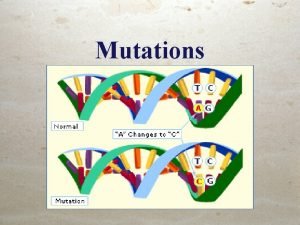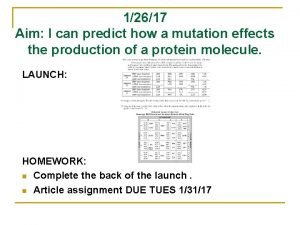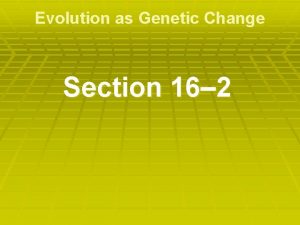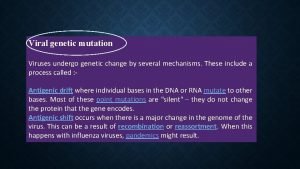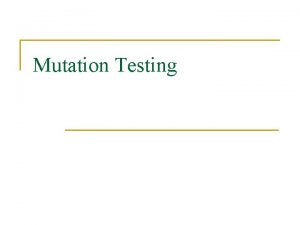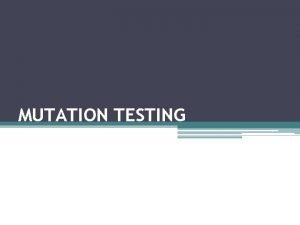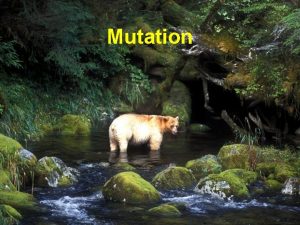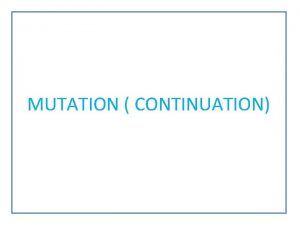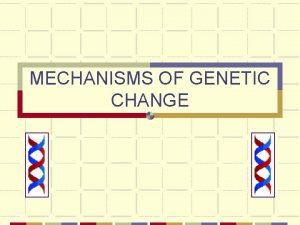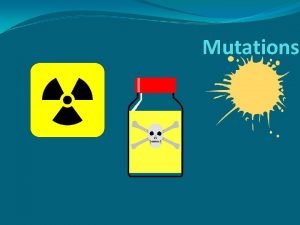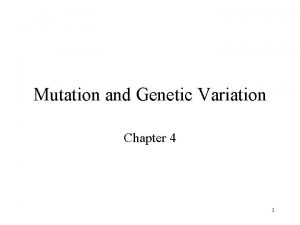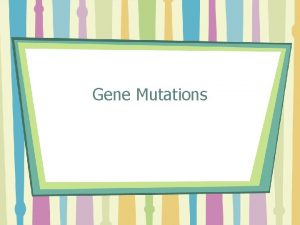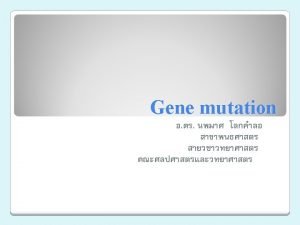Mutation Mutation is a change in the genetic














- Slides: 14


Mutation Mutation: is a change in the genetic material Mutations can be neutral, beneficial, or harmful Mutagen: Agent that causes mutations Spontaneous mutations: Occur in the absence of a mutagen

1 - Missense mutation Base substitution (point mutation) Change in one base Result in change in amino acid

2 - Nonsense Mutation Results in a nonsense codon The remaining codons of the m. RNA are not translated into amino proteins because the stop codon is prematurely reached during translation. This can yield a truncated abbreviated protein product, which lacks the functionality of the normal protein. Figure 8. 17 a, c

3 - Frameshift Mutation Insertion or deletion of one or more nucleotide pairs Due to the triplet nature of gene expression by codons this can change the reading resulting in a completely different translation from the original. The earlier in the sequence the deletion or insertion occurs, the more altered the protein produced is. Figure 8. 17 a, d

The Frequency of Mutation Spontaneous mutation rate = 1 in 109 replicated base pairs or 1 in 106 replicated genes Mutagens increase to 10– 5 or 10– 3 per replicated gene

Chemical Mutagens q Nitrous acid convert A to form that pair with C instead of T. q Analogs are molecules that are structurally similar to normal bases but have different basepairing prosperities.

Radiation 1 - Ionizing radiation (X rays and gamma rays) causes the formation of ions that can react with nucleotides and the deoxyribose-phosphate backbone

Radiation 2. UV radiation causes thymine dimers Photolyases separate thymine dimers Nucleotide excision repair Figure 8. 20

Selection Positive (direct) selection detects mutant cells because they grow or appear different Negative (indirect) selection detects mutant cells because they do not grow Replica plating Auxotroph: a mutant microorganism having a nutritional requirement that is absent in the parent cells

Ames Test for Chemical Carcinogens • Salmonella can not produce histadine • Develop mutant that enable them to produce histidine • Adding mutagen can revert mutant to original form Figure 8. 22

Genetic Recombination Vertical gene transfer: Occurs during reproduction between generations of cells. Horizontal gene transfer: The transfer of genes between cells of the same generation.

Genetic Recombination Exchange of genes between two DNA molecules Crossing over occurs when two chromosomes break and rejoin Figure 8. 23

Genetic Recombination q Genetic recombination is a process by which a molecule of nucleic acid is broken and then joined to a different one. q Recombination is a common method of DNA repair in both bacteria and eukaryotes. q In genetic engineering, recombination can also refer to artificial and deliberate recombination of disparate pieces of DNA, often from different organisms, creating what is called recombinant DNA
 Chromosomal mutation
Chromosomal mutation Genetic mutation brainpop answers
Genetic mutation brainpop answers Genetic drift vs flow
Genetic drift vs flow Gene flow vs genetic drift
Gene flow vs genetic drift Genetic programming vs genetic algorithm
Genetic programming vs genetic algorithm Genetic programming vs genetic algorithm
Genetic programming vs genetic algorithm Genetic drift
Genetic drift Section 16-2 evolution as genetic change
Section 16-2 evolution as genetic change Undergo genetic change
Undergo genetic change Mật thư anh em như thể tay chân
Mật thư anh em như thể tay chân ưu thế lai là gì
ưu thế lai là gì Tư thế ngồi viết
Tư thế ngồi viết Voi kéo gỗ như thế nào
Voi kéo gỗ như thế nào Thẻ vin
Thẻ vin Thể thơ truyền thống
Thể thơ truyền thống
